1. GBD 2015 Risk Factors Collaborators. Global, regional, and national comparative risk assessment of 79 behavioural, environmental and occupational, and metabolic risks or clusters of risks, 1990-2015: a systematic analysis for the Global Burden of Disease Study 2015. Lancet. 2016; 388:1659–1724. PMID:
27733284.
2. Ministry of Health and Welfare, Korea Centers for Disease Control and Prevention. Korea Health Statistics 2016: Korea National Health and Nutrition Examination Survey (KNHANES VII-1). Cheongju: Korea Centers for Disease Control and Prevention;2017.
6. Korean Nutrition Society. Dietary Reference Intakes for Koreans 2015. Seoul: Korean Nutrition Society;2015.
7. Jacobs DR Jr, Tapsell LC. Food, not nutrients, is the fundamental unit in nutrition. Nutr Rev. 2007; 65:439–450. PMID:
17972438.
8. Kennedy ET, Ohls J, Carlson S, Fleming K. The Healthy Eating Index: design and applications. J Am Diet Assoc. 1995; 95:1103–1108. PMID:
7560680.
9. Guenther PM, Casavale KO, Reedy J, Kirkpatrick SI, Hiza HA, Kuczynski KJ, Kahle LL, Krebs-Smith SM. Update of the Healthy Eating Index: HEI-2010. J Acad Nutr Diet. 2013; 113:569–580. PMID:
23415502.
10. Krebs-Smith SM, Pannucci TE, Subar AF, Kirkpatrick SI, Lerman JL, Tooze JA, Wilson MM, Reedy J. Update of the Healthy Eating Index: HEI-2015. J Acad Nutr Diet. 2018; 118:1591–1602. PMID:
30146071.
11. Patterson RE, Haines PS, Popkin BM. Diet Quality Index: capturing a multidimensional behavior. J Am Diet Assoc. 1994; 94:57–64. PMID:
8270756.
12. Kim S, Haines PS, Siega-Riz AM, Popkin BM. The Diet Quality Index-International (DQI-I) provides an effective tool for cross-national comparison of diet quality as illustrated by China and the United States. J Nutr. 2003; 133:3476–3484. PMID:
14608061.
13. Huijbregts P, Feskens E, Räsänen L, Fidanza F, Nissinen A, Menotti A, Kromhout D. Dietary pattern and 20 year mortality in elderly men in Finland, Italy, and The Netherlands: longitudinal cohort study. BMJ. 1997; 315:13–17. PMID:
9233319.
14. Berentzen NE, Beulens JW, Hoevenaar-Blom MP, Kampman E, Bueno-de-Mesquita HB, Romaguera-Bosch D, Peeters PH, May AM. Adherence to the WHO's healthy diet indicator and overall cancer risk in the EPIC-NL cohort. PLoS One. 2013; 8:e70535. PMID:
23950954.
15. Trichopoulou A, Kouris-Blazos A, Wahlqvist ML, Gnardellis C, Lagiou P, Polychronopoulos E, Vassilakou T, Lipworth L, Trichopoulos D. Diet and overall survival in elderly people. BMJ. 1995; 311:1457–1460. PMID:
8520331.
16. Fallaize R, Livingstone KM, Celis-Morales C, Macready AL, San-Cristobal R, Navas-Carretero S, Marsaux CF, O'Donovan CB, Kolossa S, Moschonis G, et al. Association between diet-quality scores, adiposity, total cholesterol and markers of nutritional status in European adults: findings from the Food4Me study. Nutrients. 2018; 10:e49. PMID:
29316612.
17. Korea Health Industry Development Institute. Diet-related health-risk appraisal (D-HRA) [Internet]. Cheongju: Korea Healthy Industry Development Institute;2013. 03. 29. cited 2014 May 1. Available from:
https://www.khidi.or.kr/dhra.
18. Lee M, Chae SW, Cha YS, Cho MS, Oh HY, Kim MK. Development of a Korean Diet Score (KDS) and its application assessing adherence to Korean healthy diet based on the Korean Food Guide Wheels. Nutr Res Pract. 2013; 7:49–58. PMID:
23424060.
19. Shim JE, Paik HY, Lee SY, Moon HK, Kim YO. Comparative analysis and evaluation of dietary intake of Koreans by age groups: (4) the Korean diet quality index. Korean J Nutr. 2002; 35:558–570.
20. Kweon S, Kim Y, Jang MJ, Kim Y, Kim K, Choi S, Chun C, Khang YH, Oh K. Data resource profile: the Korea National Health and Nutrition Examination Survey (KNHANES). Int J Epidemiol. 2014; 43:69–77. PMID:
24585853.
21. Korea Centers for Disease Control & Prevention. Final report for research program: development of questionnaire items and evaluation index of dietary behavior for Korea National Health and Nutrition Examination Survey. Cheongju: Korea Centers for Disease Control & Prevention;2014.
22. Yook SM, Park S, Moon H, Kim K, Shim JE, Hwang J. Development of Korean Healthy Eating Index for adults using the Korea National Health and Nutrition Examination Survey data. J Nutr Health. 2015; 48:419–428.
23. Rural Development Administration National Institute of Agricultural Sciences. Standard Food Composition Table (8th Revision). Wanju: Rural Development Administration National Institute of Agricultural Sciences;2013.
25. Drewnowski A, Rehm CD, Vieux F. Breakfast in the United States: food and nutrient intakes in relation to diet quality in national health and examination survey 2011–2014. A study from the international breakfast research initiative. Nutrients. 2018; 10:1200.
26. Murakami K, Livingstone MB, Fujiwara A, Sasaki S. Breakfast in Japan: findings from the 2012 national health and nutrition survey. Nutrients. 2018; 10:1551.
27. Reedy J, Lerman JL, Krebs-Smith SM, Kirkpatrick SI, Pannucci TE, Wilson MM, Subar AF, Kahle LL, Tooze JA. Evaluation of the Healthy Eating Index-2015. J Acad Nutr Diet. 2018; 118:1622–1633. PMID:
30146073.
28. Looman M, Feskens EJ, de Rijk M, Meijboom S, Biesbroek S, Temme EH, de Vries J, Geelen A. Development and evaluation of the Dutch Healthy Diet Index 2015. Public Health Nutr. 2017; 20:2289–2299. PMID:
28625202.
29. Wang DD, Leung CW, Li Y, Ding EL, Chiuve SE, Hu FB, Willett WC. Trends in dietary quality among adults in the United States, 1999 through 2010. JAMA Intern Med. 2014; 174:1587–1595. PMID:
25179639.
30. Hiza HA, Casavale KO, Guenther PM, Davis CA. Diet quality of Americans differs by age, sex, race/ethnicity, income, and education level. J Acad Nutr Diet. 2013; 113:297–306. PMID:
23168270.

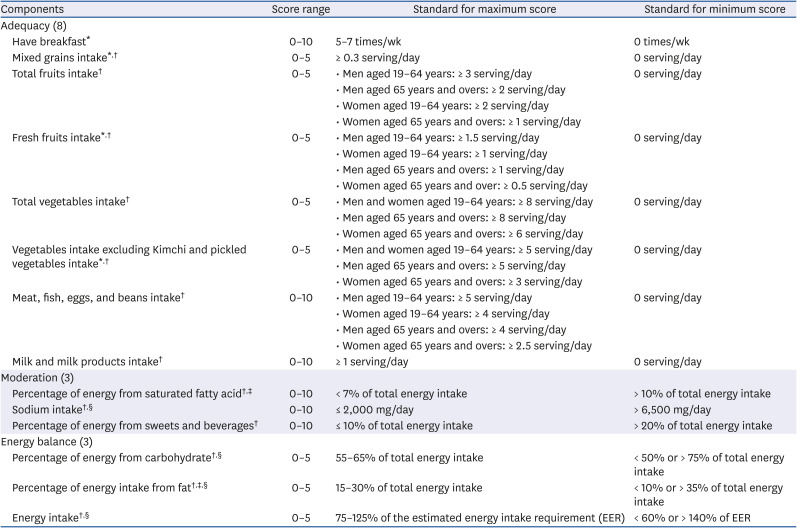
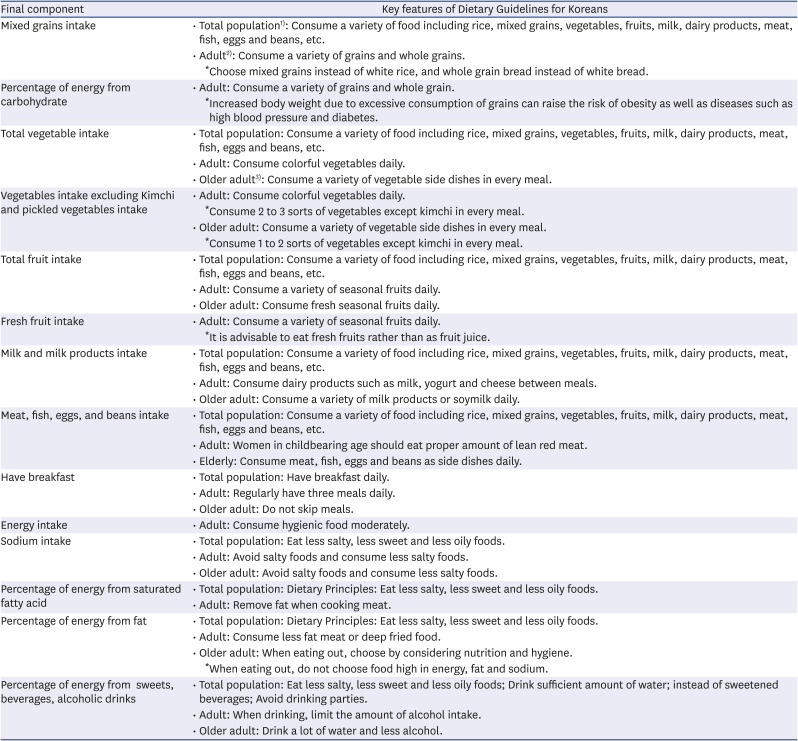
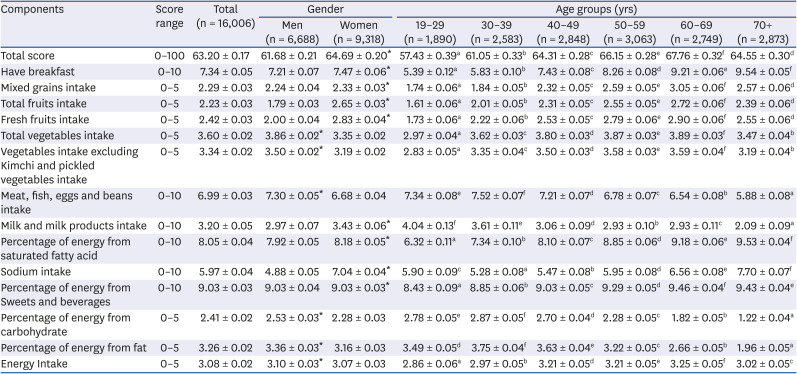




 PDF
PDF Citation
Citation Print
Print



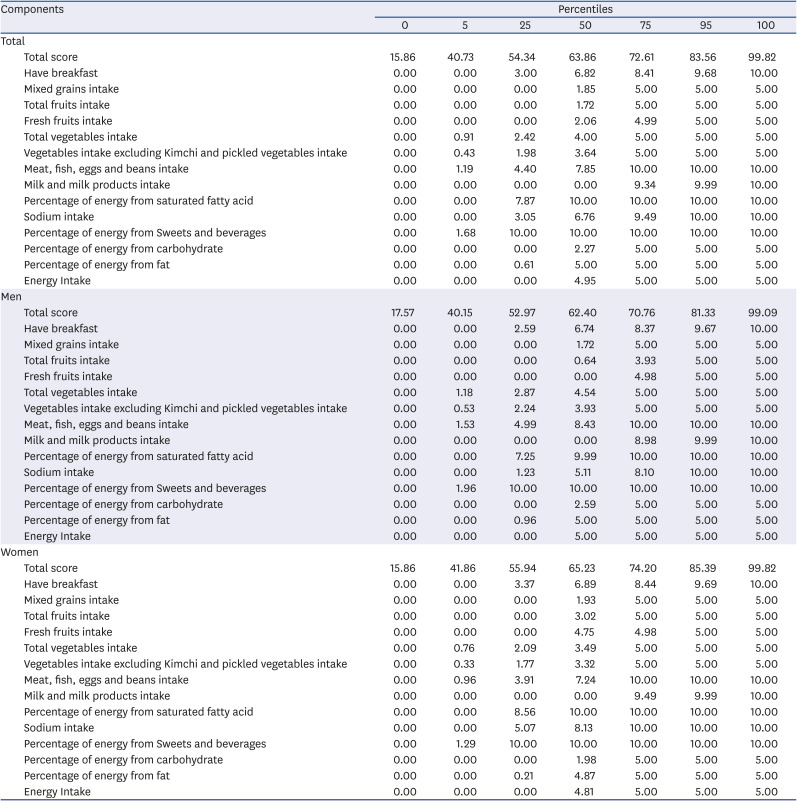
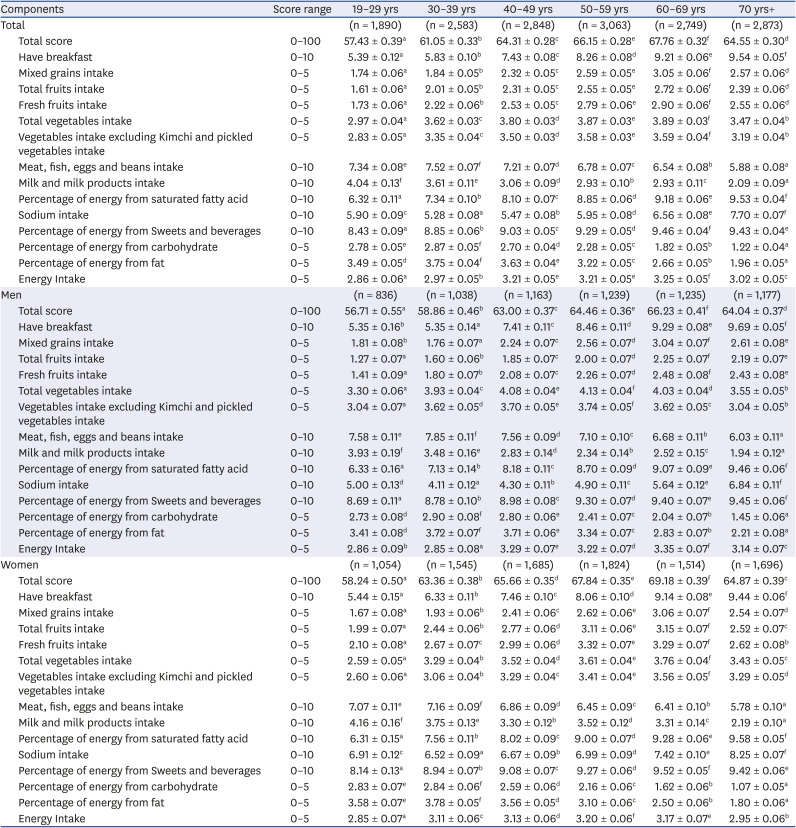
 XML Download
XML Download